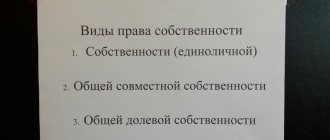VKontakte
When concluding a rental agreement for residential premises, each party reasonably wants to protect their interests and insure themselves in case of conflict.
A time-tested principle says: the more detailed the contract is, the fewer problems will arise during its execution. Therefore, a correctly compiled inventory of property is your faithful assistant when renting or renting an apartment.
What is a property inventory?
When the court makes a decision to collect funds from the debtor to pay off existing debts, enforcement proceedings are introduced.
Debts in such cases can be different: loan debts, non-payment of utilities, alimony debts, as well as other financial encumbrances. If the debtor is unable to pay off debts with cash, an inventory of the debtor’s property is made for the purpose of its subsequent sale. Enforcement proceedings, as well as an inventory of property, are carried out by employees of the Federal Bailiff Service - bailiffs.
The legal regulation of this procedure is carried out by Federal Law No. 229 “On Enforcement Proceedings”, as well as Federal Law No. 118 “On the Bailiff Service”.
When the court makes a decision to collect funds from the debtor to pay off financial obligations (in the form of a writ of execution, a court order, as well as a resolution to initiate enforcement proceedings against the defaulter), the defaulter is notified by registered mail against signature.
From this moment enforcement proceedings against the debtor begin. He has a 2-week period for voluntary repayment of existing debt. If the defaulter deliberately does not pick up the registered letter, then these deadlines do not apply to him.
How to compose and sample
The document is drawn up in simple written form. The author is the owner of the property, who must indicate in detail in the document exactly what property is being transferred for use together with the residential premises. Before signing, the tenant can make his own adjustments.
The size of the document is not regulated. This will largely depend on how large the list of property assets transferred for use is.
So, in an apartment with bare walls, the inventory may only include metering devices, plumbing equipment and a cooking stove, while in a fully furnished home the list can stretch over several pages. Any property that is valuable to the owner can be included in the inventory:
- Technique. When adding household appliances to the inventory, you must indicate the serial number of the product, color, distinctive features, year of manufacture;
- Furniture. In the absence of serial numbers, it is recommended to describe the furniture as accurately as possible, indicating color, condition, quantity and other identifying characteristics;
- Plumbing equipment;
- Small items, kitchen utensils, dishes;
- It is imperative to include all existing meters in the inventory, recording current readings, indicating their serviceability and the presence of seals.
After reading the document, the tenant can make his own amendments or make comments to the document. For example, if the inspection reveals a plumbing leak that is not listed in the description, the tenant will need to note this on the document. After the parties to the contract have compared the description with the inspection of the premises and come to an agreement on all points of the document, the actual transfer of the keys to the new residents occurs.
The transfer of housing is carried out on the basis of an acceptance certificate.
In what cases is property described?
The reason for conducting an inventory of the debtor’s property, as mentioned above, is the issuance of a court decision to collect funds from the debtor to repay the debt.
Until the court makes an appropriate decision, bailiffs will not carry out actions to arrest, inventory and confiscate the property of the defaulter. The debtor's property can be described and then sold only after the court makes a decision to begin enforcement proceedings.
An inventory of property, and accordingly its arrest, occurs in the following cases:
- when it is necessary to ensure the safety of the debtor’s existing property. This must be done so that in the future this property can be sold to pay off debts to creditors;
- to execute a court decision that orders the confiscation of property from the debtor;
- to enforce a court decision ordering the seizure of the debtor's property.
In addition, an inventory of property is made in the following situations:
- the property itself is the subject of litigation;
- the owner of the property is the plaintiff in civil proceedings;
- the debtor-defendant refuses to pay the debt under the judgment.
However, an important point must be taken into account: an inventory of the debtor’s property is not made if the writ of execution states that an amount of up to 3,000 rubles inclusive is to be collected. Such cases do not concern the seizure of collateral property, as well as a cash account.
Get a free consultation
Are there requirements for the form of the document?
The main requirement for an inventory is ease of use. The law does not limit either the content, structure, or method of creating such a document: it can be a table printed from a computer, or a list of items written by hand on a sheet of paper. The main thing is that the list contains the signatures of both parties.
Using an inventory is an effective way to regulate the relationship between the tenant and the apartment owner regarding the transferred property. It is worth spending the time and effort to compile it, and you will save yourself from possible problems.
If you find an error, please select a piece of text and press Ctrl+Enter.
How does the procedure work?
First, the bailiff checks the debtor's accounts. If the required amount to repay the debt is not available, then the bailiff has the right to visit the debtor to make an inventory of the property.
Typically, bailiffs carry out an inventory of property at the place of registration or place of actual residence.
Bailiffs can make an inventory of the debtor's property on weekdays from 6.00 to 22.00. In special cases, bailiffs have the right to carry out the procedure on weekends and holidays, as well as at night.
If the debtor interferes with the performance of official duties of the bailiffs (does not open the door, refuses to let the bailiffs into the residential premises), then in this case they have the right to forcefully enter the premises, inspect and describe the property. With the written permission of the senior bailiff, the bailiff may force the door.
When making an inventory of property, the presence of witnesses (at least two) is required. In this case, the debtor does not have to be present during the inventory. This was done intentionally so that the debtor would not interfere with the implementation of enforcement proceedings. It turns out that it is possible to describe, seize, and also sign the inventory report without the presence of the debtor-defendant.
Participants in the procedure for inventorying the debtor's property are:
- bailiff;
- the debtor or to represent him (relatives of the debtor can act as representatives: parents, spouse);
- witnesses (at least two);
- the person who receives the debtor's property that is under arrest or storage.
The bailiff begins his work with an inventory of the debtor's property.
Important! Property that does not belong to the debtor, but is owned by third parties (relatives, spouse), is not included in the inventory report and is not subject to seizure. To do this, interested parties must provide evidence that the property is their property (for example, checks, sales agreement) and does not belong to the debtor. Property whose owner is unknown is also included in the inventory act.
Also, during the procedure for inventorying and seizing the debtor’s property, a preliminary assessment is made. If the total amount of the inventory exceeds 30,000 rubles, the property must be assessed by an appraiser. Less than 30,000 rubles - bailiff. The debtor has the right to disagree with the assessment of the value of the seized property, about which a corresponding entry is made in the inventory report. In this case, the debtor can file a complaint with the court within 10 days, and also hire an appraiser at his own expense.
The seized property must correspond to the amount of debt the debtor owes to creditors. For example, if a debtor has a debt of 15,000 rubles to creditors, then the bailiff has no right to describe property for a large amount.
The final stage of making an inventory of the debtor's property is the preparation of a special legal document - an inventory act. The inventory report includes the following information:
- date, time and place of the inventory;
- Full name and passport details of the plaintiff and defendant;
- Full name and passport details of the persons participating in the inventory;
- Full name and passport details of the person to whom the debtor’s things are transferred for storage (if there is one);
- contents of the inventory act;
- a list of items of the debtor’s property that are included in the inventory, with a description of their characteristics (quantity, color, condition, etc.);
- the approximate estimated cost of items, as well as the timing of their sale. The total amount of seized property.
The property inventory report is drawn up in 2 copies: for the bailiff, as well as for the debtor-defendant. All participants in the property inventory procedure must sign the document.
From this moment on, the debtor’s seized property, contained in the inventory act, cannot be sold, donated, transferred to third parties, or left as an inheritance.
Upon completion of the inventory of the debtor's property, an entry is made in the act that the person who accepted the seized property was explained his rights and obligations. The specified person bears full responsibility for the safety of the property entrusted to him.
The illegal actions of a bailiff can be challenged in court.
Example
Inventory of property
Appendix No. 1 to the “Apartment Rental Agreement” No. 23465 dated October 15, 2020
Signed in Moscow on October 20, 2021
We, Ilya Ivanovich Grigoriev, residing at the address: Moscow, Pushkina street, no. 10, apt. 41, below referred to as “Lessor”, on the one hand, and Egor Aleksandrovich Demidov, passport series 54 09, number 236875, issued 07/30/2007 Department of Internal Affairs for the Yaroslavl district of Moscow, below referred to as the “Tenant”, on the other hand, preserving the terminology of the specified Lease Agreement, with this Inventory we confirm the following:
- Simultaneously with the Premises, the Lessor transferred and the Tenant accepted for free use the following property located in the Premises:
- Furniture set “Victoria” - 6 items: bed (1 pc.), bedside table (2 pcs.), chest of drawers (1 pc.), wardrobe with a mirror door (1 pc.), chair (1 pc.), walnut color ", excellent condition, no defects.
- Bed linen - 3 sets, color: blue, white, green.
- Leather “Stella” chairs - 2 pcs., beige color, good condition, 2 scratches on the right side.
- Carpet — 1 piece, color green, good condition, small blue paint stain on one side.
- Gas stove "Electra" - 1 pc., model EK-65, serial number 123456, working condition, no defects.
- In case of loss or damage to property, the Tenant undertakes to pay compensation to the Lessor, depending on the amount of damage caused.
- The relations of the parties are determined by the specified Lease Agreement, the Inventory and the Civil Code of the Russian Federation.
- The inventory is compiled in 2 copies - one for each side.
Lessor: Grigoriev I.I.
Tenant: Demidov E.A.
4.Rights of the bailiff and debtor
Bailiff's rights:
- bailiffs can make an inventory of property at the place of registration or place of actual residence of the debtor;
- The permitted time for the procedure is weekdays from 6.00 to 22.00. In “emergency” cases, this condition may be violated.
- bailiffs have the right to open the debtor's doors to allow access to the home and conduct a search, and then an inventory of the property. Such actions can be carried out in the presence of witnesses, as well as a local police officer;
- In their work, bailiffs can make requests to banks about the accounts of the defaulter, as well as make requests to Rosreestr and other organizations to obtain information about the debtor’s real estate;
- in addition to the amount of the debt, the bailiff collects an enforcement fee, the amount of which is 7% of the amount of the debt;
Debtor's rights:
- the debtor has the right to be present during the property inventory procedure;
- When making an inventory of property, the debtor can stipulate which things can be included in the inventory act in the first place. The bailiff is obliged to satisfy this demand of the debtor. However, if the amount received from the sale of the specified property is not enough, then the inventory of the property continues until the debt burden is fully repaid;
- the debtor has the right to hire an appraiser at his own expense if he does not agree with the amount of valuation of his property.
Get a free consultation
Comment on the rating
Thank you, your rating has been taken into account. You can also leave a comment on your rating.
Is the sample document useful?
If the document “Act of Transfer of Property to a Residential Tenancy Agreement” was useful to you, we ask you to leave a review about it.
Remember just 2 words:
Contract-Lawyer
And add Contract-Yurist.Ru to your bookmarks (Ctrl+D).
You will still need it!
What are they describing?
According to the law, the following groups of property of the debtor can be described and seized:
- real estate. However, inclusion of the debtor's real estate in the inventory has a number of features. These nuances will be discussed below;
- luxury goods, including jewelry of various types. As a rule, this group includes things of high value, as well as cultural significance: works of art (paintings, figurines, manuscripts, etc.), antiques, souvenirs. All these things have no practical use, but due to their high cost they can be sold to pay off existing debts.
- Appliances. There are also nuances here, we will consider them below.
- securities: shares, bonds, etc.;
- vehicle.
According to the Civil Procedure Code of the Russian Federation (Article 446), the following categories of property of the debtor are not subject to recovery in enforcement proceedings:
- housing of the debtor, if it is the only one for him and his dependents. If the debtor owns several apartments, one of them (or several) can be described and then sold at auction. It is worth considering that the amount of debt must be commensurate with the value of the property sold. That is, due to a small debt, expensive property is not sold.
- land plots on which the debtor's real estate is located;
- food products, in almost unlimited quantities. The law prescribes criteria for assessing the “need” of food products. Their amount must be at least the subsistence level for each family member. The exception is if it is a product intended for commercial sale, that is, purchased by the debtor for sale or to hide available funds;
- items of necessary furniture, household items, including hygiene items;
- personal achievement items. This includes certificates, awards, cups, memorial signs, etc.;
- Kids' things;
- pets, livestock, as well as buildings and premises necessary for their maintenance;
- seeds for planting;
- vehicles and fuel for it, if they are intended for the performance of professional activities (taxi drivers, drivers, etc.). Also, vehicles specially equipped for people with disabilities (cars for disabled people) are not subject to arrest;
- items and means necessary for disabled people (for example, a wheelchair);
- household appliances in a single copy. Bailiffs have the right to describe and seize all other equipment.
How detailed should I fill out?
It is necessary to fill out the document in as much detail as possible, since in the event of controversial situations, it is on the basis of the inventory that the damage caused is calculated, which will have to be compensated by the tenant. All items in the inventory must be described in as much detail as possible . The following information should be included:
- quantity and appearance;
- manufacturer's name and year of manufacture;
- condition and degree of wear;
- presence of defects: cracks, scratches, chips.
If there is nothing to describe?
Quite often, bailiffs are faced with a situation where the debtor does not have the funds to pay off debts, as well as property that can be sold. Such defaulters do not own real estate (or, if they have it, it is the only one), the car is not registered to the debtor, and the bailiff did not find any securities in his possession.
How is this situation resolved? Article 46 of the Federal Law “On Enforcement Proceedings” says: the bailiff has the right to return the writ of execution to the claimant and ends this proceeding with a special resolution. The defaulter-defendant is subject to the restrictions imposed on him (accounts, property, etc.).
However, this is not the end of the debt recovery story for the debtor. Debt obligations remain. And the creditor-plaintiff, if an improvement in the financial situation of the debtor is detected, can again turn to the bailiffs to start proceedings. This will restart the entire process.
Legality of retention of the debtor's property
There is a generally accepted practice.
When renting out the premises, the tenant must hand over the property free of his property. If, instead of proper delivery, he runs away, “forgetting” to pay his debts and take the property, then the tenant automatically becomes a violator of the rules established by law. The landlord again has the right to own and use the vacated premises, and, accordingly, the right to retain all property left on the premises. The exception is the case when the contract expressly prohibits such retention.
The retention mechanism is regulated by Articles 359, 360 of the Civil Code of the Russian Federation. Property that an attacker leaves in a rented premises can be classified as abandoned, in accordance with the terms of Article 226 of the Civil Code of the Russian Federation, which means that other persons have the right to acquire such property as property if a number of conditions are met. The Presidium of the Supreme Arbitration Court of the Russian Federation, in its information letter dated January 11, 2002 No. 66, emphasized that withholding is possible if both persons are entrepreneurs and the lessor did not prevent the debtor from returning the property during the term of the lease agreement.
Retention is allowed only until the debt is paid off and is considered legal if the lease agreement is terminated. According to Article 606 of the Civil Code of the Russian Federation, the lessor provides the premises for temporary possession and use; accordingly, while the agreement is in force, the lessor cannot limit the debtor’s rights. When the tenant violates payment terms 2 or more times in a row, the landlord will have the right to demand early termination of the contract. To do this, you must notify the debtor in advance in writing. This provision is contained in Article 619 of the Civil Code of the Russian Federation. If the contract does not provide for the possibility of unilateral termination, then the tenant must go to court or wait for the expiration of the contract.
Eduard Kobyakov Head of Legal
In general, the retention mechanism is an effective measure that encourages the tenant to pay off debts faster. In addition, the mechanism has a compensating function due to the possibility of selling retained property if the stimulating effect does not work.
What happens next? (Seizure and sale of property)
The sale of the debtor's property occurs in the following way:
- through special stores (if these are, for example, household appliances, furniture, jewelry, etc.);
- through organized auctions. Here the debtor's property exceeding 500 thousand rubles is sold. As a rule, this concerns the sale of the debtor’s real estate (apartment, house, land), as well as property of high value (securities, car, antiques, etc.).
If a bailiff seizes property worth less than 30 thousand rubles, the debtor can agree to independently sell this property.
Seized property that is subject to sale is usually valued at average market prices.
For example, a similar used television is offered for sale from 3 thousand to 5 thousand rubles. Consequently, the defaulter’s TV can be valued at 4 thousand rubles. This scheme for calculating the value of property is approximate and is not always applied. If the debtor does not agree with the proposed valuation of his property, he can challenge it and involve an appraiser in the work. But he will do it at his own expense.
If seized property put up for sale does not find a buyer, then after a month its value will be reduced by 15%. In another month – 25% lower than the original cost.
Is it possible to return seized property put up for sale?
Theoretically, it’s possible. But if the total amount of the debt differs significantly from the amount of the property being redeemed, then the debtor will not be able to return the desired item. The defaulter will need to repay the existing debt in full. Then the thing dear to the debtor will return to its owner again. And yet, if the property has been sold, then it will not be possible to return it.
Practice confirming the legality of retention
The established judicial practice confirming the legality of the actions of creditors holding property is sufficient.
In Saratov, an unscrupulous landlord was refused to reclaim property left in unpaid premises (case No. 2-2837/2018) In Chuvashia, last year a similar decision was made No. 2-621/2018 2-621/2018 ~ M-260/2018 M- 260/2018 dated May 23, 2021. More examples of good practice can be seen in cases No. A56-40614/2016 and A68-10567/2016. However, in Tatarstan, arrears in rent payments were collected from the landlord, but the tenant was obliged to return the property to the owner (decision No. 2-1220/2018 2-1220/2018 ~ M-992/2018 M-992/2018 dated May 21, 2021 in case No. 2-1220/2018). What to do if the debtor, after retaining the property, comes to the landlord with representatives of law enforcement agencies
The law is on the side of the landlord if the latter did everything correctly. It is enough to explain the current situation to law enforcement officers, demonstrate the lease agreement, documents confirming the debt and evasion of its payment, demands, claims, an invitation to open the premises and draw up an inventory, the inventory itself and all prepared acts.
How does bankruptcy help?
Getting into a debt hole is not a tricky thing. It is much more difficult to get out of it. If you cannot cope with the debt burden on your own, then it is better to turn to specialists. The individuality of each situation, a large number of legal procedures, court hearings can greatly complicate the already stressful life of the debtor. Moreover, the higher the amount of financial obligations, the more attractive the advantages of the bankruptcy procedure seem.
The undoubted and main advantage of bankruptcy is the write-off of debts (full or partial), which certainly outweighs the restrictions from its completion.
It is better to entrust the solution of financial problems to specialists who have proven themselves in their field.
To summarize, we can draw the following conclusions:
- An inventory of the debtor's property is understood as a legal procedure, the purpose of which is to obtain funds through the sale of the property of the obligated person. This procedure is carried out by specially authorized persons - bailiffs.
- The procedure for inventorying the debtor's property begins with the initiation of enforcement proceedings, i.e. By the tribunal's decision. The legal basis for this is a writ of execution, a court order, as well as a resolution to initiate enforcement proceedings against the defaulter.
- An inventory of the debtor's property, as a rule, takes place at the place of his registration or actual residence. The permitted time period for the work of bailiffs to inventory property is working days from 6.00 to 22.00.
- Participants in the procedure for inventorying the debtor's property are: bailiff; the debtor or his representative; the person receiving the debtor's property for safekeeping; witnesses.
- In the process of making an inventory of the debtor's property, a preliminary assessment is made. If the total amount of the property inventory is up to 30 thousand rubles. – the assessment is made by a bailiff; if more than 30 thousand rubles. – an appraiser is hired. The amount of the preliminary assessment will later be included in the inventory report of the debtor’s property.
- Not all of the debtor's property is subject to inclusion in enforcement proceedings. The inventory does not include: the debtor’s only home; the land plot on which the debtor's house is located; food (at least the subsistence level for each family member); necessary furniture, household and hygiene items; items of personal achievements (cups, certificates, medals, etc.); Kids' things; domestic animals and livestock necessary for farming (including facilities for their maintenance); seeds for planting; vehicles and equipment necessary for the professional activities of the debtor; vehicles and items necessary for a disabled debtor; necessary household appliances in a single copy.
- If the debtor does not have property that could be included in the inventory of property, then the bailiff has the right to return the writ of execution to the claimant and completes this proceeding with a special resolution. However, this does not mean the termination of debt obligations and the writing off of the debtor's debts. If his financial situation improves, the creditor-plaintiff can again turn to the bailiffs to start proceedings.
- The final stage of making an inventory of the debtor's property is drawing up a property inventory act. It must be drawn up and signed in a clearly regulated form by the participants in the procedure. The finished inventory act is drawn up in 2 copies: for the bailiff and for the debtor-defendant. All participants in the property inventory procedure must sign the document.
Get a free consultation
How to enter data when hiring?
The result of the transfer of transferred material assets when renting out an apartment is an act. It is a table describing the transferred items.
Before the table you need to indicate the address and characteristics of the apartment:
- room area;
- separation or adjacency of rooms;
- the presence of a loggia or balcony;
- the condition of the walls, floor and ceiling, finishing materials (for example, a suspended ceiling or a floor covered with parquet, as well as tiles on the wall should be reflected in the inventory);
- condition of the entrance and the presence of interior doors;
- other indicators that you consider important.
Let's move on to filling out the table:
- Name of property - pay attention to the correct indication of the name of the property to protect yourself from disagreements in the future.
- Quantity - usually in pieces. For single large items such as a sofa, it is not particularly important and is a purely formal indicator, but it will not hurt if you decide to record the number of silver teaspoons in the kitchen cabinet.
- Condition – excellent, good, satisfactory. The parameter is often subjective, but important for assessment.
Note: the tabular form is not strictly necessary and is used only for ease of use.
If it is more convenient for you to sketch out a list or create an inventory in the form of continuous text, it will also be valid. Therefore, the choice is yours.
How is an apartment inspection carried out?
An important point when conducting an inspection is attentiveness .
The landlord enters all the necessary property, and the tenant can make additions. The inventory includes defects, scratches, chips, equipment and furniture, and its performance.
Inspection of the apartment includes a complete audit of the availability of all property .
The document includes the following inspection categories:
- electronic devices, household appliances, Internet modem or connection - the model, release, device number and its operating condition are indicated. For example, a 1.5-liter Vitek electric kettle, purchased in 2015, worked properly when turned on, there is no filter in the spout;
- switches, sockets, carriers, light bulbs - check working condition, presence of contact connection;
Note to both parties - when setting a date for inspection, take with you, for example, a charger to check sockets.
- plumbing equipment - the operation of taps, drains, showers is inspected, and the presence of leaks is checked;
- gas equipment - the boiler, how it works, the gas stove, the working condition of the burners and oven are also inspected;
- small household items - the presence of dishes, flower pots (description, chips, scratches);
- utility meters - indicators are necessarily recorded, you can take photographs and attach them to the inventory, the presence of seals is recorded, the latest payment receipts are inspected;
- furniture - number of cabinets, tables, chairs, curtains, mirrors, etc.
Find out how to properly inspect an apartment here.
Damage to property during rental
The most common disputes occur between the tenant and the landlord due to damage to property.
There is such a thing as natural wear and tear - decoration, furniture and appliances have their own service life.
If property damage occurs, which can be attributed to natural wear and tear, the tenant does not always agree to compensate for the damage.
The landlord will be protected by an agreement that will spell out the extent of the tenant's liability for damage to property, as well as photographs taken before the tenant moved in and after the discovery of defects. All this will help the owner succeed in court.
If you want to learn how to quickly sell an apartment during a crisis, then this article will be useful to you.
In any case, you need to figure out whether the equipment has failed due to natural wear and tear or due to improper use.
To avoid having to sue the tenant, it is best to insure the apartment that is being prepared for rent in advance. All experts advise this.
How to inspect an apartment?
Inspect the apartment carefully so that it doesn’t turn out later that you are not happy with anything.
The owner has the right to include all the things he sees fit, and the future tenant can make additions. The presence of all defects and scratches is described, and the equipment is checked for functionality.
- Property available in the apartment. For example: a wall carpet, red, size 3x2, has a gray oblong spot in the lower left corner. Scratches on furniture, wobbly chairs, a broken interior door handle - all this should be included in the inventory.
- Household appliances and electronics. The model, year of manufacture, and serial number of the device must be entered. For example: Samsung TV, 42-inch diagonal, year of manufacture 2014, serial number FD4357891, no faults detected when turned on, Tefal electric kettle, no serial number, detected defect - no automatic shutdown when boiling.
If you want to know that renting out an apartment by the day is a profitable business, we advise you to read this article.






